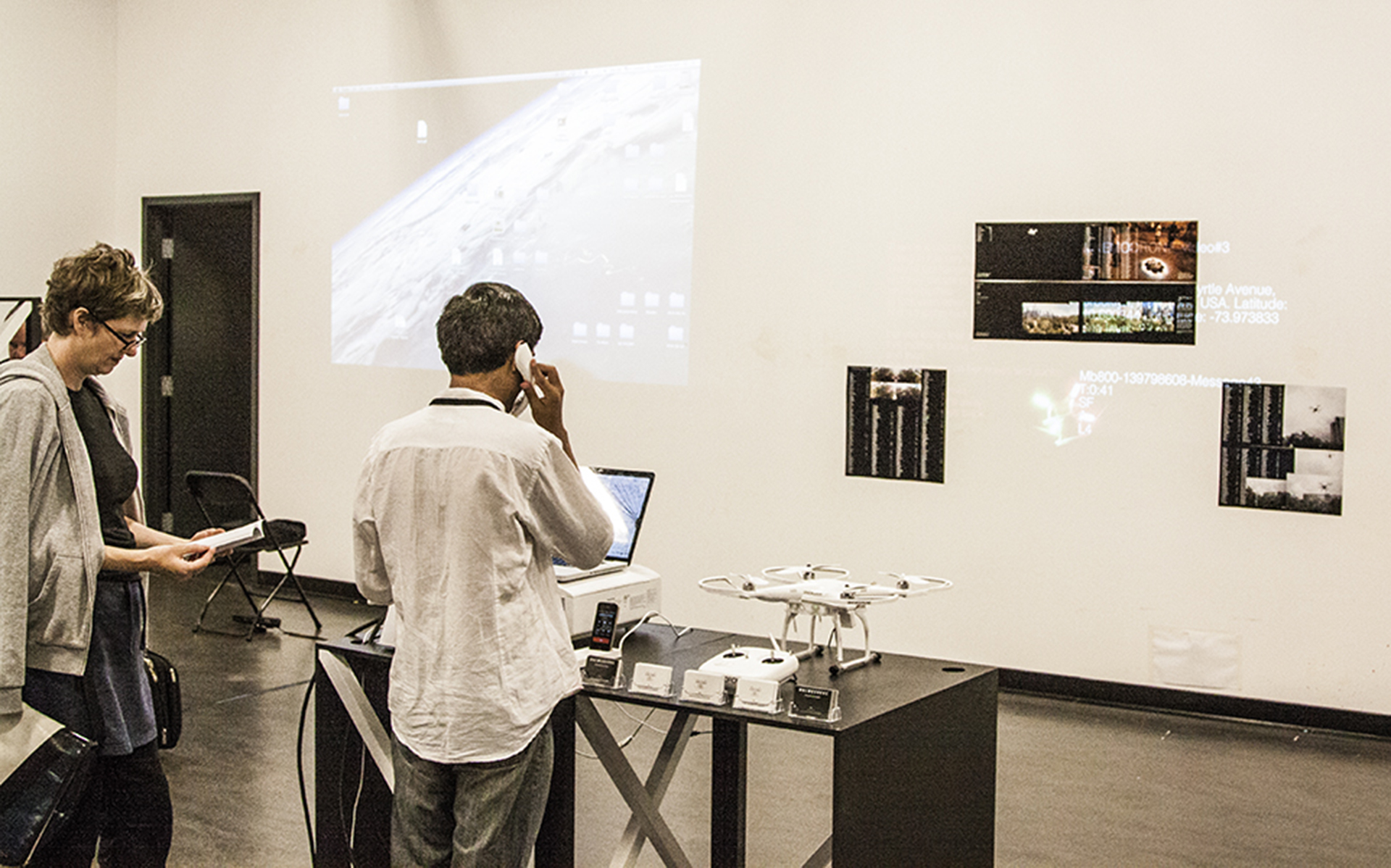ENG – ITA
MNEMODRONE, 2014-in progress. Mixed media, multiple locations.
MNEMODRONE is a transmedia memory-collecting project, developed in collaboration with Daniel Belquer, based on drone technology that investigates the social and philosophical issues of coexistence between humans and artificial intelligences.
MNEMODRONE is divided into chapters, and every chapter is developed within a particular socio-cultural context (a festival in public spaces, an art gallery, a conference, etc.). For every chapter, the project is exhibited differently, alongside a printed publication that organizes data, questions, theories, and working hypotheses, leading to a constant evolution of the project itself. MNEMODRONE merges practical and theoretical artistic experimentation with advanced technological research through a self-reflective logic in which the object of investigation and the methodology constantly interact and influence one another.
.
INDEX
CHAPTER ONE
CHAPTER TWO
CHAPTER THREE
CHAPTER FOUR

CHAPTER FIVE
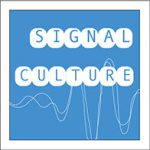
.
.
INTRODUCTION

Two years ago, the Federal Aviation Administration (FAA) announced that in less than 20 years, there will be 30,000 drones flying over the American soil, watching the entire country. Now we’re at the beginning of that process, and the FAA still has little knowledge of what kinds of drones are going to take over the sky. What is even more difficult to foresee, is the kinds of relationships that will develop between humans and drones. On top of this we should add the fact that simple artificial intelligences are already a reality and that in twenty years they could reach levels currently considered purely speculative. This is the context in which MNEMODRONE project was developed and articulated.
Our questions: Is it possible for a machine to act based on collective memories? What kind of memories are people willing to share with a machine? Are we ready to believe that a machine can develop a personality? What’s the difference between memory, personality and consciousness? Is it possible to develop a consciousness based on collective memories? Can consciousness be artificially developed? What’s the relationship between memory and consciousness? What kind of relationship between humans and machines can emerge from the drone-collected data? What makes people start or stop collaborating with machines? Will people experience the project as a new invasion of their precarious privacy? Will people think of it as a scientific experiment, an event, a game or all of these things in various combinations? Will people refuse to take part in it? And what can that tell us about humans? Are we able to share memories with a machine in the same way we share memories with a real person?
.
.
CHAPTER ONE: AIOP Festival, October 9-12th 2014, on 14th Street, NYC
.
The project made its debut at the AIOP Festival, where we asked the public to share a selection of their memories with a small flying drone, simply by recording a voice message through a toll-free phone number. The drone started out with an “empty memory” and is only programmed to fly and store memories; it doesn’t speak and doesn’t interact directly with the public. The public decided which memories, or none at all, to share with MNEMODRONE. What the public was told is that the drone will later transform according to what they share with it. A written documentation, which includes the transcript of all the memories collected during the first chapter, is available on demand here
.
CHAPTER TWO: Re-Fest Art + Technology Festival, CULTUREHUB, New York, November 21-23rd 2014
.
For CHAPTER TWO, we continued to gather memories. This time the setting was different: we were inside a gallery instead of in a public space, and we also presented a photographic and multimedia installation as part of our self-reflective methodology. CHAPTER TWO included a photographic and multimedia installation, a drone-performance and a talk. Additionally, a written publication about CHAPTER ONE was included as part of our self-reflective methodology. People were able to share memories calling from their phones or using a specific docking station. A written documentation, which includes the transcript of all the memories collected during the first chapter, is available on demand here.
.
.
CHAPTER THREE: ISEA2015, 21st International Symposium on Electronic Art, Vancouver, August 14-18, 2015
.
A detailed update will be published soon!
.
CHAPTER FOUR: Made in New York Media Center by IFP, The Arbitrary Art of Numbers, curated by Hans Tammen, Brooklyn, December 2015
A detailed update will be published soon!
.
CHAPTER FIVE: Signal Culture, Researcher in Residency Program, Owego, New York, January 28th – February 11th, 2016
.
A detailed update will be published soon!
.
FOLLOWING CHAPTERS: Two Possibilities, from March 2016
.
- FIRST POSSIBILITY: We decide to develop further collaborations and extend the timeline of the project. The drone keeps collecting human memories through public appearances, while developing its “personality” based on the collected data. The way the drone will react to those memories is an open question that we won’t answer alone. In order to develop an A.I. platform able to modify itself through data analysis, we would collaborate with one or more A.I. researchers.
- SECOND POSSIBILITY: We decide to end the public appearances of MNEMODRONE, without actually developing a specific A.I. but instead starting the final stage.
- We are also working on the possibility of developing MNEMODRONE-App in order to facilitate the sharing of memories and to bring the project virtually to every smartphone around the world.
.
FINAL CHAPTER: Interdisciplinary Interpretations
.
- At the end, we will have access to the database of memories people have shared with the drone. We intend to use that material to understand how people engaged with MNEMODRONE: what the limits, concerns, important points, and ambiguities were in this process. We will draw from this material in order to create a complex body of artworks. Even if every appearance of MNEMODRONE is an event on its own, the project will only be complete after sifting through the collected memories.
- MNEMDRONE’s conclusion is not intended to be the resolution of all posed questions, nor as an arrival point per se. Instead it is the conclusion of this specific collaborative effort, and an opening towards new practical and theoretical development for this research. We already know that to the current list of questions and working hypotheses (all regularly included in the printed publications produced at the end of every chapter) others will undoubtedly be added.
- For the final chapter, we will focus on the issues and questions raised by the project in an interdisciplinary way that goes beyond the limits of scientific and social analysis, and speculate on possible answers.
- The project was made possible thanks to the generous support of Claudio Amparo – Tijolo Intermedia Brazil. Thanks to Katie Sundsted (editor of the MNEMODRONE – CHAPTER 2 publication) and Matt Fidler (editor of the MNEMODRONE – CHAPTER 1 publication).
- CON IL SOSTEGNO DEL PROGETTO DE.MO./MOVIN’UP I sessione 2015 / WITH THE SUPPORT OF THE PROJECT DE.MO./MOVIN’UP 1st session 2015. MOVIN’UP I sessione 2015 A CURA DI: MINISTERO DEI BENI E DELLE ATTIVITA’ CULTURALI E DEL TURISMO (Direzione Generale Arte e Architettura Contemporanee e Periferie Urbane, Direzione Generale Spettacolo), e GAI – Associazione per il Circuito dei Giovani Artisti Italiani / MOVIN’UP I session 2015 promoted by: Ministry of Cultural Heritage and Activities and Tourism (General Directorate for Contemporary Art and Architecture and Urban Suburbs, General Directorate for Performing Arts), and GAI – Association for the Circuit of the Young Italian Artists.
(SELECTED) BIBLIOGRAPHY

[INTERVIEW]
Exibart
“Digitale Off Limits: intervista a Emilio Vavarella”
Interview by Maria Chiara Wang, July 2020. (ita)
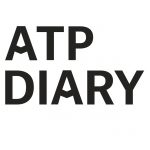
[PRESS COVERAGE]
ATP Diary
“Ramdom a Gagliano del Capo, Lecce: fare e vivere di cultura e arte”
Interview by Elena Bordignon. 21 November 2019. (ita-eng)
[SOURCE]

[WRITTEN CONTRIBUTION]
Low Form. Imaginaries and Visions in the Age of Artificial Intelligence
Vavarella, Emilio. “What is it like for a computer bot to be a computer bot?” and “Visual Essay”
Catalogue of exhibition at MAXXI – Museo nazionale delle arti del XXI secolo, CURA Editions, 2018 (ita-eng).

[WRITTEN CONTRIBUTION]
Robot Love: Can We Learn From Robots About Love?
Vavarella, Emilio. “Interview with a Drone”
Catalogue of exhibition at Niet Normaal Foundation, 2018 (eng).

[INTERVIEW]
Objects.
“Glitch, quando l’errore diventa arte. Intervista a Emilio Vavarella”
Interview by Maria Chiara Wang, 2018. (ita)
[PDF | SOURCE | ARCHIVED]

[ACADEMIC PAPER]
Digital Creativity
Vavarella, Emilio. “Interview with the Drone: Experimenting with Post-Anthropocentric Art Practice”
Edited by Stanislav Roudavski, Special issue on Post-Anthropocentric Creativity, Routledge, vol.27. n.1. 2016 (eng).

[INTERVIEW]
GAI Giovani Artisti Italiani: Diario Web
“Il Progetto. L’Invervista. Il Resoconto”
Interview by Valeria Lacarra, 2015. (ita)
[SOURCE | PROJECT]

[INTERVIEW]
ATP Diary
“Nuove ipotesi di realtà. Intervista con Emilio Vavarella (New hypotheses of reality: interview with Emilio Vavarella)”
Interview by Elena Bordignon, January 2020. (ita-eng)
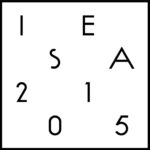
[EXHIBITION CATALOGUE]
Official Catalogue ISEA 2015: Art and Disruption
“MNEMODRONE”
by Kate Armstrong, 2015, p.73. (eng)

[PROJECT REVIEW]
ATP Diary
“MNEMOSCOPIO di Emilio Vavarella: un’installazione d’arte pubblica”
by Irene Angenica, March 2020. (ita)

[INTERVIEW]
AIOP FREE Sneak Peek!
“Emilio Vavarella and Daniel Belquer ‘MNEMODRONE'”
2014. (eng)
[SOURCE]

[ARTICLE]
SottoboscoDigitale: Artisti Digitali Italiani.
“Emilio Vavarella, Questione di Memoria”
by Valeria Crisafulli, 2018 (ita)
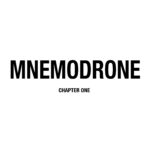
[ARTIST BOOK]
MNEMODRONE – CHAPTER TWO
Part of the “MNEMODRONE” project, edited by Vavarella, Emilio and Daniel Belquer.
Independent publication developed for ISEA2015 – 21st International Symposium on Electronic Art, Disruption, NYC, 2015, US (eng).

[ARTIST BOOK]
MNEMODRONE – CHAPTER ONE
Part of the “MNEMODRONE” project, edited by Vavarella, Emilio and Daniel Belquer.
Independent publication developed for CultureHub, RE FEST: Art + Technology Festival, NYC, 2015, US (eng).

[INTERVIEW]
Artribune
“Tessitura, memoria e tecnologia. Intervista a Emilio Vavarella”
by Cecilia Pavone, September 2020. (ita)
[SOURCE (ita) | ARCHIVED]

[BOOK]
Arte e tecnologia del terzo millennio. Scenari e protagonisti [Art and Technology in the Third Millennium: Landscapes and Protagonists]
Catricalà, Valentino and Cesare Biasini Selvaggi, I Quaderni della Collezione Farnesina, Vol. II, Milan: Mondadori Electa, 2020. (ita-eng)
[PDF ]

[PROJECTS REVIEW]
Neural
“MNEMOSCOPIO and rs548049170_1_69869_TT (The Other Shapes of Me)”
by Alessandro Ludovico, Issue 67, Autumn 2020. (eng)
[PDF | PROJECT (1) | PROJECT (2)]


















